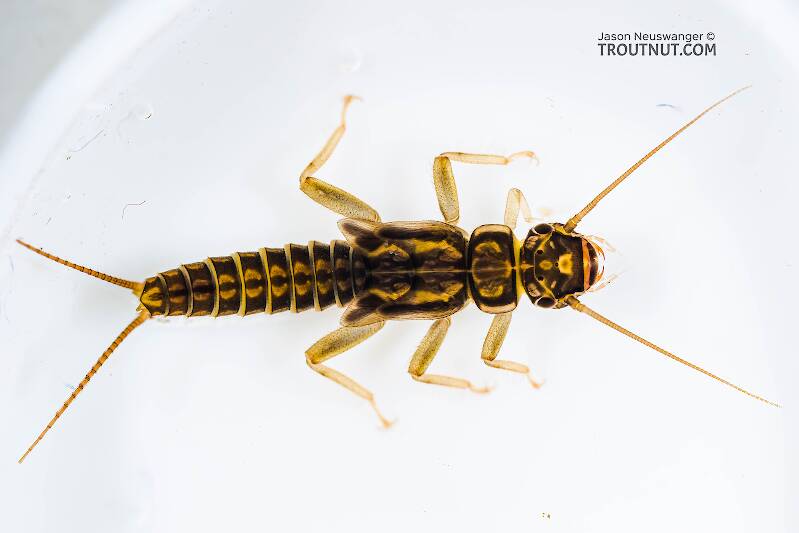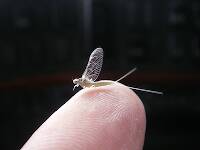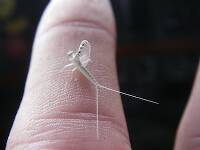
Hex Mayflies
Hexagenia limbata
The famous nocturnal Hex hatch of the Midwest (and a few other lucky locations) stirs to the surface mythically large brown trout that only touch streamers for the rest of the year.
Featured on the forum


Troutnut is a project started in 2003 by salmonid ecologist Jason "Troutnut" Neuswanger to help anglers and
fly tyers unabashedly embrace the entomological side of the sport. Learn more about Troutnut or
support the project for an enhanced experience here.
Goose
Posts: 77
Posts: 77
Goose on Nov 7, 2006November 7th, 2006, 2:21 am EST
I believe my buddy tied some Klinghamers on light wire scud hooks and he couldn't get them to float upright. Does the Klinghamer require the Klinghamer hook? He thought maybe it was because the circumference of his hackle was too small. Should the hackle be larger for the Klinghamer to keep it upright?
GONZO on Nov 7, 2006November 7th, 2006, 3:22 am EST
Hi Goose-
Hans van Klinken designed a special hook for Partridge, but I've never used it. (I haven't seen it in the shops I frequent--probably a special order deal.) I like the Mustad C49S for "Klinks" and many other half-in/half-out flies. The slightly heavier wire helps to sink the body.
Several things could be influencing the "orientation" problem your friend is experiencing.
Perhaps the body material is too buoyant or too heavily applied. This will prevent the body from penetrating the film, tipping the fly on its side. A heavier wire hook (like the C49S) might help, as might a wire rib or underbody. He could also try a surfactant (like Gerhke's Xink) on the body (or just squeeze some water into the body streamside before casting).
Perhaps the wing post is too tall or uses too much material in proportion to the hook size. If he's using a synthetic post, it's easy enough to trim the post until the fly balances better. Parachutes need to have more weight below the hackle than above to work properly. If he's not dressing the post with floatant, the wing might be getting wet and becoming too heavy.
Hackle size or stiffness might be an issue. Many tiers use slightly oversize hackles on parachutes. Untreated hackle with too much "web" could also collect water and interfere with performance.
Finally, your friend might simply be delivering his cast too hard and too low. Heavily hackled traditional dries tend to be forgiving of poor delivery. They are so air-resistant that it is hard to fire them forcefully at the surface. But most other dries need a little "hang-time" to properly orient before landing. Because many of my dry fly patterns have far less air-resistance than traditionally hackled patterns, I've noticed that some casters (who are used to the forgiveness of standard hackle) tend to pound them into the water with out giving them a chance to align in the air.
Sorry to offer so many possibilities; but orientation of the fly on and in the water is a very important issue in my own tying, so I've experimented with it extensively. If I could see the fly it would be easy to identify the problem. Have your friend try this: Fill a sink or basin with water and toss or drop the flies onto the surface. If they alight properly, it's a casting issue. If not, experiment with some of the other things I've suggested until the proper performance is achieved.
I never take a new fly design to the stream without "water-testing" it first. One of the most valuable things to keep near your tying table is a glass of water!
Hope that helps,
Gonzo
Hans van Klinken designed a special hook for Partridge, but I've never used it. (I haven't seen it in the shops I frequent--probably a special order deal.) I like the Mustad C49S for "Klinks" and many other half-in/half-out flies. The slightly heavier wire helps to sink the body.
Several things could be influencing the "orientation" problem your friend is experiencing.
Perhaps the body material is too buoyant or too heavily applied. This will prevent the body from penetrating the film, tipping the fly on its side. A heavier wire hook (like the C49S) might help, as might a wire rib or underbody. He could also try a surfactant (like Gerhke's Xink) on the body (or just squeeze some water into the body streamside before casting).
Perhaps the wing post is too tall or uses too much material in proportion to the hook size. If he's using a synthetic post, it's easy enough to trim the post until the fly balances better. Parachutes need to have more weight below the hackle than above to work properly. If he's not dressing the post with floatant, the wing might be getting wet and becoming too heavy.
Hackle size or stiffness might be an issue. Many tiers use slightly oversize hackles on parachutes. Untreated hackle with too much "web" could also collect water and interfere with performance.
Finally, your friend might simply be delivering his cast too hard and too low. Heavily hackled traditional dries tend to be forgiving of poor delivery. They are so air-resistant that it is hard to fire them forcefully at the surface. But most other dries need a little "hang-time" to properly orient before landing. Because many of my dry fly patterns have far less air-resistance than traditionally hackled patterns, I've noticed that some casters (who are used to the forgiveness of standard hackle) tend to pound them into the water with out giving them a chance to align in the air.
Sorry to offer so many possibilities; but orientation of the fly on and in the water is a very important issue in my own tying, so I've experimented with it extensively. If I could see the fly it would be easy to identify the problem. Have your friend try this: Fill a sink or basin with water and toss or drop the flies onto the surface. If they alight properly, it's a casting issue. If not, experiment with some of the other things I've suggested until the proper performance is achieved.
I never take a new fly design to the stream without "water-testing" it first. One of the most valuable things to keep near your tying table is a glass of water!
Hope that helps,
Gonzo
Mvbelzen
Posts: 1
Posts: 1
Mvbelzen on Jan 21, 2007January 21st, 2007, 6:20 am EST
Use the right materials for the klinkhamer. I'm fishing a lot of years with this extremely good floating fly. Tie it on the right way and use the right materials. Do not use heavier hooks because that wil be influence the bouancy negative. Use the Partridge Flash Point 158 N Klinkhammer or the Partridge flash Point 158 NX.
And grease only the wing. Do not grease the Body and Torax.
Regards,
Rinus van Belzen
The Netherlands
And grease only the wing. Do not grease the Body and Torax.
Regards,
Rinus van Belzen
The Netherlands
Quick Reply
Related Discussions
Topic
Replies
Last Reply
10
Jul 27, 2008
by Phillyfired
by Phillyfired
7
May 29, 2012
by Possumpoint
by Possumpoint



